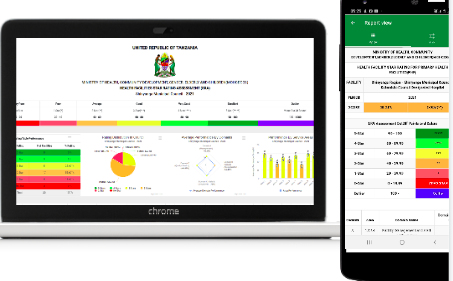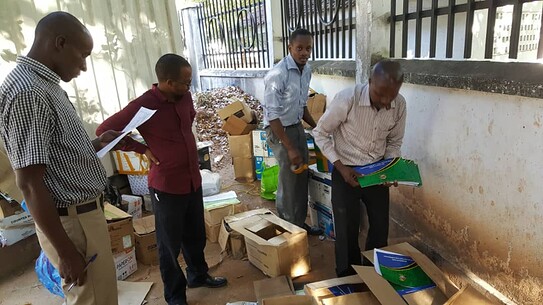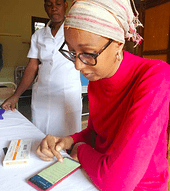By Hassan Muhomi, @waltervfaustine, and @vincentminde, @DAC2022
UDSM DHIS2 Lab
1. Introduction
1.1 Background
Tanzania’s government has been using a star rating system to evaluate the performance of various healthcare facilities in order to improve healthcare in the country since 2015. The focus was on primary health care facilities and district hospitals, which account for more than 90% of all health facilities in Tanzania, with the goal of having at least 80% of primary health care facilities rated three stars or higher. The Star Rating uses a 5-star rating system for health facilities, with the more stars indicating better service. National and local government assessors worked together to manually assess individual health facilities before digitizing the responses to an excel template to compute facility stars. Assessors were required to re-enter data into the national HMIS in order for facility and council management teams to access identified gaps for improvement.
Figure 1: National assessors preparing for Star rating assessment (by then Big Results Now) using paper tools in 2017.
1.2. Challenges experienced with paper tools star rating assessment
The Ministry of Health and its partners recognize the importance of providing citizens with high-quality health care through healthcare facilities. Despite this, patients have expressed dissatisfaction with the level of healthcare services given. Patients’ discontent with healthcare facilities’ health services limits their use of those services, perhaps leading to an unhealthy society that is unable to fully participate in production activities. By that time, the cost of facility assessment and star rating had risen due to the printing of paper tools with over 900 assessment indicators per tool, the time spent assessing one area at a time and digitizing into an EXCEL template and HMIS, the inability to assess multiple service areas from different departments due to shared printed paper tools, and the inability to provide immediate facility star computation and feedback to the healthcare facility management for improvement.
2. The Implementation Method
The Ministry of Health (MOH) in collaboration with the University of Dar es Salaam (UDSM) DHIS2 Lab and stakeholders decided to digitize the process by extending the use of DHIS2 to customize the MOH Star Rating Assessment (SRA) android application for facility assessment and star rating. Assessors are able to smoothly conduct assessments with the use of the SRA offline mobile app even if they have limited or no internet connectivity, and later on synchronize data with the national HMIS server. Through HMIS, SRA facilitates the generation of offline and online reports, as well as the download of facility Star Rating certificates showing the number of stars achieved.
The implementation began with a review and digitization of indicators from a variety of service areas, including management, staffing levels, facility cleanliness and equipment, drug availability, patient wait times, services provided to patients, and whether staff are polite and respectful to patients, among others. The application had a pilot test at 28 healthcare facilities in one of Tanzania’s most rural district councils. The feedback from the pilot test was used to fix identified bugs and improve the application. The User Acceptance Test (UAT) and Training Of Trainers (TOT) were conducted to national assessors from the ministry and selected districts, followed by training for local government assessors before the real assessment.
The application was designed to be general, inheriting user and system configurations from the deployed DHIS2 installation, and assigning assessors specialized roles for data management, form locking, and report access.

Figure 2: National Assessor conducting Star Rating Assessment with a digitized tool in mobile device, and SRA Report displayed both in offline mobile tool and in web app using data from one of the assessed facility
3. Achievements of using MOH SRA App in assessing and rating healthcare facilities in Tanzania
The SRA mobile app was used to assess 2,587 public and private healthcare facilities across ten regions, allowing different actors to access and obtain facility star, performance of specific clinical service areas, key performance indicators, and performance by health facility type. The implementation enables the download of the facility star rating certificate as well as access to QIP for the identified deficiencies. It also ensures that all data is available in the system after the assessment and gives access to a healthcare facility’s performance shortly after the evaluation is done in a facility with restricted or no internet connectivity.
The usage of the MOH SRA application in facility assessment and star rating has reduced paperwork, reduced printing expenses, freed assessors from manually digitizing indications and their scores in an excel template, and simplified the facility assessment and star rating procedure. By triangulating between facility star ratings and related service data, managers and planners can quickly conduct studies using evaluation data in HMIS.
Figure 3: Performance of facilities with 3 stars and above and a sample copy of Certificate awarded to facilities after Star Rating Assessment (Source: HMIS-DHIS2 Tanzania)
4. Next Steps
By allowing data to be gathered offline using mobile devices and automatically synchronized with the national HMIS server, the MOH SRA App has proved its promise in simplifying healthcare facility assessment and star ranking. The effort and costs of the assessor have been reduced by more than 80% as a result of this deployment. However, the ministry and non-state actors are examining whether the facility star may be compared to the performance of some indicators for reported data on specific services to see whether there is a link between the two. The UDSM DHIS2 Lab, in collaboration with the Ministry of Health, plans to continue innovating, expanding, and refining the app by adding features to suit present and upcoming needs, allowing health managers to better understand barriers to excellent healthcare and successful interventions.



